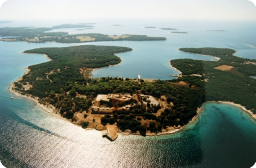

Brioni National Park
Brioni National Park  Saline
Saline
In the deep southern cove of Veli Brijun behind Cape Gromače, you will find the Saline bird reserve. It stretches over an area of 7 hectares, and is known for its marsh plants and three small lakes. Within the complex of the largest lake, hidden by the reeds, lies a secluded small island with a straw-covered hut where Josip Broz Tito used to relax while listening to birds singing.
This bird reserve developed on the remains of medieval salt pans, which had grown up on earlier ancient pans, traces of which are still visible today along the coast. The significance and importance of the salt pans can best be seen in documents stating that the profit of Brijuni's salt sales is "an extraordinary profit for the Venetian Republic" or that those planning to start their own salt production should "visit the salt pans of Inzulae Brionorum that have been an example of top quality activities for centuries". With the land reclamation works of 1960, the area of salt pans was filled in. Two small lakes were formed and in 1973 a third one was added. At this time, the largest lake and surrounding area assumed their final functional and landscape form, so that this area became a meeting place for resident and migratory bird species, a true ornithological park.



Today, Brijuni ornithological park offers a fascinating and idyllic image of various bird species swimming in the small lakes or hiding in the Mediterranean maquis or marsh plants. This rare and exceptional area, truly different from the usual Istrian landscape, can be easily reached, except during nesting (April and May), by walking around the small lake or can be seen from several elevated observation posts. Besides the rich variety of wildlife, for the lucky few, Brijuni ornithological park also offers the opportunity of dining inside the straw hut accompanied by the sound of birds singing.
Source: http://www.brijuni.hr/
Video
Current news
 Macrocruise charter agency
Additional discount on the boat rental price of betw
Macrocruise charter agency
Additional discount on the boat rental price of betw





























